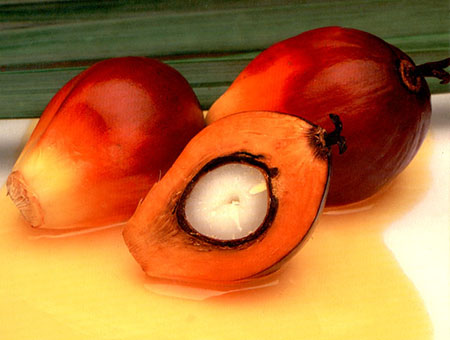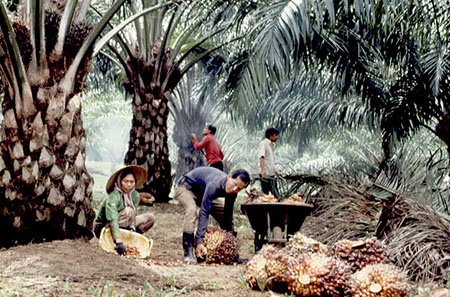Some advantages over other vegetable oils

Currently the world’s fastest-growing animal-production sector, aquaculture is expected to continue expanding rapidly to meet the seafood demands of a growing human population. This increased production must be supported by a corresponding increase in the production of formulated aquafeeds.
Fish oil is currently an important ingredient in commercial aquafeeds, which use an estimated 60 percent of global fish oil supplies. By 2010, this consumption could rise to about 80 percent of the world supply.
Produced from small, pelagic fishes, fish oil is a finite fishery resource that has reached a production plateau in the last decade. To sustain the growth of the aquaculture industry, alternatives to fish oil are becoming increasingly crucial.
Palm oil
One potential substitute for fish oil in aquafeeds is palm oil, which is the second most abundant vegetable oil in the world. Global production of palm oil in 2000 amounted to 21.7 million tons, compared to about 1.4 million tons of fish oil.
Source of beta-carotene, vitamin E
Crude palm oil is extracted from the outer flesh of fruit from oil palm trees. When freshly extracted, palm oil is the richest known natural source of beta-carotene, which gives the oil its characteristic deep orange-red color. Palm oil is also a rich source of vitamin E, consisting of tocopherols and tocotrienols. Table 1 shows additional properties of palm oil.
Ng, Chemical properties of Malaysian crude palm oil, Table 1
| Chemical Characteristics | Range of Values |
|---|
Chemical Characteristics | Range of Values |
|---|---|
| Iodine value (Wijs) | 50.6-55.1 |
| Saponification value (mg KOH/g oil) | 190.1-201.7 |
| Melting point (° C) | 30.8-37.6 |
| Fatty acid composition (%) | |
| 12:0 | 0.1-1.0 |
| 14:0 | 0.9-1.5 |
| 16:0 | 41.8-46.8 |
| 16:1 | 0.1-0.3 |
| 18:0 | 4.2-5.1 |
| 18:1 | 37.3-40.8 |
| 18:2n-6 | 9.1-11.0 |
| 18:3n-3 | 0.05-0.6 |
| 20:0 | 0.2-0.7 |
| Vitamin E (ppm) | 600-1,000 |
| Carotenoids (ppm) | 500-700 |
Uses
During refining, the carotenoids in crude palm oil are thermally destroyed and the oil bleached to produce the desired color for a refined, bleached, deodorized palm oil. The refined palm oil can be fractionated by thermomechanical processes to produce palm olein, used mainly in cooking oil, and palm stearin for margarine and shortening.
Encouraging research results

Research on the use of palm oil in fish diets has shown encouraging results. Palm oil in the diets of catfish (Ng et al. 2000, Lim et al. 2001, Ng et al. 2002) and Atlantic salmon (Bell et al. 2002) resulted in growth and feed efficiency comparable to that of fish fed equivalent levels of dietary fish oil.
The inclusion of at least 8 percent crude palm oil or palm olein in African catfish (Clarias gariepinus) diets significantly improved growth performance, dietary protein retention, and vitamin E concentration in fillets of this fish (Lim et al. 2001). Recently, we also showed that palm oil products can be effectively used in hybrid red tilapia diets without compromising fish health, growth or feed efficiency.
Palm oil advantages
Palm oil offers high availability and low cost, especially in tropical countries. It also has additional advantages over other vegetable oils when used in aquafeed formulations.
High oxidative stability
The combined effects of high levels of carotenoids, tocopherols, and tocotrienols, and a 50 percent saturation of fatty acids give palm oil higher oxidative stability than most conventional vegetable oils. This reduces the incidence of rancidity when oils are incorporated at high levels in feeds.
Antioxidative properties
Bioaccumulation in fish fillets of the powerful natural antioxidants vitamin E and carotenoids enhances flesh quality and prolongs the shelf life of aquaculture products. The possible role of these antioxidants in enhancing fish reproductive performance and immune response is currently being investigated.
Energy source
Palm oil is a superior source of dietary energy. In vitro studies on mitochondrial β-oxidation in fish suggest a substrate preference for the saturated and monounsaturated fatty acids abundantly found in palm oil over polyunsaturated fatty acids (PUFA). Studies by the Fish Nutrition Laboratory at the Universiti Sains Malaysia have shown the protein-sparing effect of palm oil in catfish diets.
HUFA requirements
Palm oil does not contain highly unsaturated fatty acids (HUFA), which are required by some aquaculture species. Consequently, palm oil in these diets should be formulated in conjunction with HUFA sources such as fish oil and fishmeal to assure that minimum HUFA rerquirements are met.
Human benefits
Contemporary human diets have caused our intake of omega-6 fatty acids to increase, drastically altering dietary omega-3:omega-6 ratios. These ratios vary from 1:2.5 for Eskimos on a fish-based diet to 1:20 for modern diets rich in vegetable oils. Eskimos who rely on their traditional diets are relatively free of degenerative diseases common to urban dwellers.
Some health workers have advocated a 1:4 omega-3:omega-6 ratio. It is generally known that the fatty acid composition of fish fillets reflects the fatty acid composition of the dietary oil used (Bell et al. 2002; Ng et al. 2002). Since our diets already have too much omega-6 PUFA, a good fish oil substitute should limit its deposition in fish fillets. This makes palm oil superior to soybean oil and sunflower oil, which contain high proportions of omega-6 PUFA that would be deposited in fish fillets when used in aquafeed formulations.
Conclusion
Continuously expanding oil palm cultivation in Malaysia and other tropical countries offers the possibility of a sustainable alternative to fish oil in aquafeeds. Further pilot-scale studies are being conducted to fully exploit palm oil as a dietary lipid source for several aquacultured species.
(Editor’s Note: This article was originally published in the April 2002 print edition of the Global Aquaculture Advocate.)
Now that you've finished reading the article ...
… we hope you’ll consider supporting our mission to document the evolution of the global aquaculture industry and share our vast network of contributors’ expansive knowledge every week.
By becoming a Global Seafood Alliance member, you’re ensuring that all of the pre-competitive work we do through member benefits, resources and events can continue. Individual membership costs just $50 a year. GSA individual and corporate members receive complimentary access to a series of GOAL virtual events beginning in April. Join now.
Not a GSA member? Join us.
Author
-
Wing-Keong Ng, Ph.D.
Fish Nutrition Laboratory
School of Biological Sciences
Universiti Sains Malaysia
Penang 11800, Malaysia
Tagged With
Related Posts

Aquafeeds
Alternative lipids spare fish oil in rainbow trout feeds
Alternative lipids have achieved varied success in ensuring adequate growth and fatty acid composition in fillets. The authors evaluated rainbow trout raised on diets containing fish oil or a blend of fish and standard or modified lipids varying in fatty acid composition.

Intelligence
Analysis of global diets highlights persistent undernutrition
Climate change, shifting incomes and evolving diets complicate the search for solutions to obesity and undernutrition in vulnerable populations.

Intelligence
Behold the nutritious oyster
Oysters provide important, natural filtration of water and are an important component of many healthy coastal ecosystems because their active filtering can help improve and maintain water quality. For many coastal communities, oysters are an important food resource and excellent sources of protein and amino acids, zinc, selenium, iron and B-vitamins.

Responsibility
Climate change likely already affecting global food production
Study of potential impact of observed climate change on the yields of 10 global crops show a likely 1 percent average reduction in consumable food calories.


